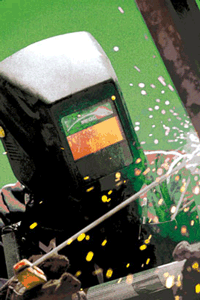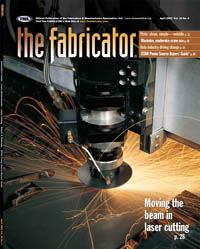Contributing Writer
- FMA
- The Fabricator
- FABTECH
- Canadian Metalworking
Categories
- Additive Manufacturing
- Aluminum Welding
- Arc Welding
- Assembly and Joining
- Automation and Robotics
- Bending and Forming
- Consumables
- Cutting and Weld Prep
- Electric Vehicles
- En Español
- Finishing
- Hydroforming
- Laser Cutting
- Laser Welding
- Machining
- Manufacturing Software
- Materials Handling
- Metals/Materials
- Oxyfuel Cutting
- Plasma Cutting
- Power Tools
- Punching and Other Holemaking
- Roll Forming
- Safety
- Sawing
- Shearing
- Shop Management
- Testing and Measuring
- Tube and Pipe Fabrication
- Tube and Pipe Production
- Waterjet Cutting
Industry Directory
Webcasts
Podcasts
FAB 40
Advertise
Subscribe
Account Login
Search
One man's junkyard is another man's playground
'Junkyard Wars' features fabricating at its grittiest
- By Kevin Cole
- April 15, 2002
- Article
- Arc Welding
Many viewers have been tuning in to The Learning Channel's (TLC) "Junkyard Wars" to watch people use the same tools and techniques that shop floor workers use every day. There is no doubt that competition is a standard part of the manufacturing world. But, "Junkyard Wars" has taken that competition to a new level and found plenty of people to participate in its scrap heap challenge.
The Premise
Each episode of the show pits two teams of three against each other in a junkyard full of bruised and battered machines. At dawn teams learn what they must construct that day, which might be anything from a racecar to a rocket. They then have 10 hours to design and build their machines.
The teams have access to any tool they might need, as well as an expert in a relevant field who can steer them in the right direction. Once they have their design, tool-toting team members must race to find parts to build their Frankensteinian fabrications. All this for a chance at a trophy and bragging rights.
The filming of each episode actually takes place over two days, the first of which is used to build the machines and the second to test them. The teams battle in play-off-style tournaments, with the two best teams battling it out in the last episode. The machines are judged on the basis of field-specific criteria, with the winning team advancing and the losing team heading back to the scrap pile.
Two hosts provide the play-by-play for each mechanical match-up, talking to the teams about the strategy they'll be using. The hosts also get some objective outsider opinions, talking to that day's judge, who's an expert in that particular episode's mechanical field.
Why Have Junk Wars?
The show, now in its sixth season, has attracted quite a following. It continues to gain popularity with each episode, and dozens of Web sites have sprung up in dedication to it. But TLC and participants alike are hoping it will be more than just entertaining. TLC specializes in having an educational twist to all of its programs, and "Junkyard Wars" is no exception.
As the fabricators hammer away at their creations, the show explains the technology involved in each design, giving short tutorials on everything from scuba diving to aeronautics, often diagramming the problems the teams encounter and possible solutions. Complex ideas are put into terms that even children can understand. According to the first U.S. team on the British version of the show, the New England Rubbish Deconstruction Society (or NERDS as they call themselves), "Junkyard Wars" reaches people of all ages.
"This planet needs a lot more kids who think taking the lawnmower's engine apart is more fun than playing Nintendo®," they state on their Web site. "The real point of the show is not the competition. Its real goal is to teach some science, and get some kids to think that engineering or something similar can be a fun thing to do with your life. The competition is (in part, anyway) a trick to get them to watch those explanatory drawings until the end."
Genesis of the Idea
The show originally aired in the U.K. under the name "Scrapheap Challenge," and its success led to the American version. Cathy Rogers, the show's producer and host, came up with the idea for the show with a fellow producer after seeing "Apollo 13."
"When the engineers dump that huge box of rubbish to try to fix the carbon monoxide filters, I could just feel the tension building in the theater," she said. "A mechanical competition like 'Junkyard Wars' captures that same sort of thing, combining that boyish obsession with machines with the thrill of competition."
Since being volunteered to host the show, Rogers has been required to dive into subzero waters, cower in bunkers with explosives going off overhead, and ride through a tank course in a jeep with no wheels. But she said what is more enjoyable has been getting to know the contestants on the program, who come from a variety of fields to test their mettle in this cult-competition.
Who Is on the Show, and What Do They Make?
An amazing range of talented people from disparate backgrounds have appeared on the show. Most of the teams are made up of everyday people with a manufacturing background, from mechanical engineers to shop welders and everything in between. One team that competed in 2001 was the Hicks family.
Led by 49-year-old Sam Hicks, the team included his two daughters, Shannon ("Jakey") and Anna. The Hicks, who live in Oregon, flew to Sun Valley, Calif., to square off in a showdown with another Oregon team, in which the groups transformed scrap metal into working cannons. Sam said his background as a hull technician during his 20-year stint in the Navy was good preparation for the sort of fabrication that takes place on the set.
"I did a lot of repair on ships and submarines—piping systems, plates, the whole nine yards," he said. "We also did a bit of metal cutting and bending and a lot of welding." Sam explained that he spent 36 weeks in welding school learning everything from shielded metal arc welding (SMAW) to gas metal arc welding (GMAW) and gas tungsten arc welding (GTAW). "I've always enjoyed this type of work."
His love for manufacturing and fabrication work shows. Even after retiring from the service he has continued to work in the field.
"After the Navy, I worked for a company that built rock crushers and worked on machines in the field," he said. "I also worked for a company that builds hay presses."
Today Sam continues this type of work, putting in hours at a small fab shop working on farm equipment for Steffen Systems and Randall Steffen Farms. His dedication to the field paid off during his junkyard battle—his team won the first competition and advanced to the next round by building a cannon out of a 3-1/2-inch-diameter, 4-1/2-foot-long piece of scrap tubing; old car parts; and a lot of solid welding wire.
During this second round, Sam and his daughters were surprised to learn they were to build a working flying machine. Although they were knocked out of the tournament at that stage, they displayed a valiant effort even though none of them had any hands-on experience with airplanes or flying.
Sam said he was persuaded to go on the show by his daughters, who brought him a videotape of it to review before hitting him up with the idea of actually competing. After finding information on the Internet about how to get on the show, Sam decided that trying out wouldn't hurt, so he and his daughters created a videotape of themselves in action to send to the producers.
"My daughters and I got together and built a phonograph out of a funnel, needle, battery-operated drill, and a coffee can, and it worked!" he said. "It was hard to believe, but it did work.
"My daughters were really the ones who wanted to do it," admitted Sam. "But once we got accepted by the show, I was all for it." He said his welding skills became very important during the competition and that his daughters, although they do not work in the fabrication field, were no strangers to the shop setting.
While the contestants are mostly "everyday Joes," the expert ringers brought in for each team are some of the top people in their respective fields, such as Mike Fergusson, 1997 Indy Car Fabricator of the Year, and Justin Manley, a research engineer at Massachusetts Institute of Technology.
As for what they have made on the show, the answer is just as diverse as the contestants. During its tenure on TLC, "Junkyard Wars" has produced hot rods, ballistic missiles, off-road vehicles, power boats, underwater breathing apparatus, Hovercraft®, rockets, siege engines, power pulling machines, land yachts, amphibious vehicles, fuel-efficient vehicles, underwater salvage equipment, monster trucks, cranes, and harvesting machines, just to name a few.
And since its inception, the show has spawned a spinoff,"Junkyard Mega-Wars,"which incorporates three teams, three challenges, and a race into the formula, and TLC is working on a similar show called "Ultimate Machine Combat."
More information on "Junkyard Wars" is available at junkyardmegawars.com.
Photos courtesy of The Learning Channel.
About the Author
subscribe now

The Fabricator is North America's leading magazine for the metal forming and fabricating industry. The magazine delivers the news, technical articles, and case histories that enable fabricators to do their jobs more efficiently. The Fabricator has served the industry since 1970.
start your free subscription- Stay connected from anywhere

Easily access valuable industry resources now with full access to the digital edition of The Fabricator.

Easily access valuable industry resources now with full access to the digital edition of The Welder.

Easily access valuable industry resources now with full access to the digital edition of The Tube and Pipe Journal.
- Podcasting
- Podcast:
- The Fabricator Podcast
- Published:
- 04/16/2024
- Running Time:
- 63:29
In this episode of The Fabricator Podcast, Caleb Chamberlain, co-founder and CEO of OSH Cut, discusses his company’s...
- Trending Articles
Steel industry reacts to Nucor’s new weekly published HRC price

How to set a press brake backgauge manually

Capturing, recording equipment inspection data for FMEA

Are two heads better than one in fiber laser cutting?

Hypertherm Associates implements Rapyuta Robotics AMRs in warehouse

- Industry Events
16th Annual Safety Conference
- April 30 - May 1, 2024
- Elgin,
Pipe and Tube Conference
- May 21 - 22, 2024
- Omaha, NE
World-Class Roll Forming Workshop
- June 5 - 6, 2024
- Louisville, KY
Advanced Laser Application Workshop
- June 25 - 27, 2024
- Novi, MI




























